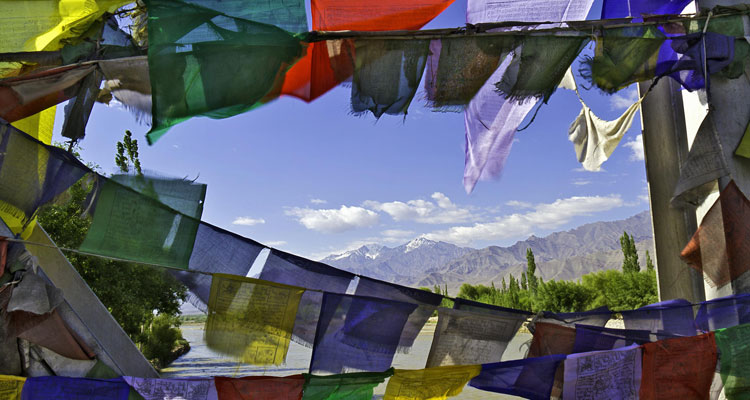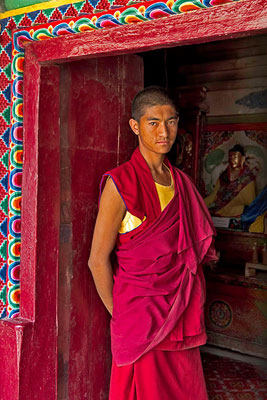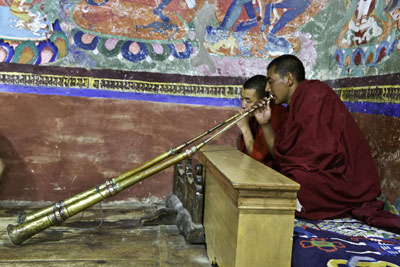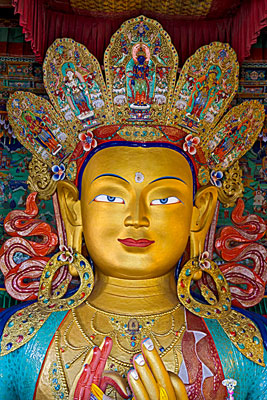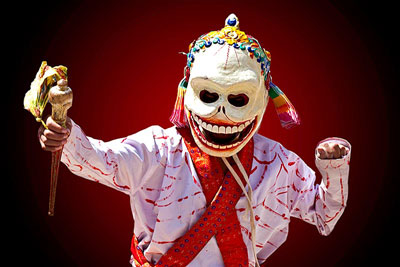Ladakh — reaping the rewards of a private tour in this remote northern India region
by Steven Emmet; Solana Beach, CA
“Julay!” That’s really the only word you need to know if visiting Ladakh, as it means ‘Hello,’ ‘Good-bye’ and ‘Thank you!’ — very useful. Stress the latter syllable and put your right hand, palm facing left and fingers slightly flexed, in front of the center of your face, accompanied by a slight bow of the head, and you’re set!
Why Ladakh?
Ladakh has some of the oldest and most famous Buddhist gompas (monasteries), and it’s a bit off the beaten path, both of which interested my wife, Yuki, and me.
Until recently, one of the only ways to traverse the countryside was by trekking; however, this wasn’t particularly high on our list of preferred modes of travel. Then I read an article in the New York Times about luxury trekking in Ladakh.
This had a nice ring to it, so I contacted Ms. Lucy Davison of Banyan Tours & Travel (Delhi, India) by e-mail and then Skype (lucy.davison). Lucy assured me that I didn’t need to do any actual trekking at all and said she and her colleagues could create any type of tour that Yuki and I wanted — and they did. I have never experienced the care, cosseting and professionalism that Lucy and her group provided.
Getting there
I arranged for business-class tickets on American Airlines, which we upgraded to first class, paying a total of $11,000 plus 25,000 miles. Alas, even first class was not, well, first class.
The plane proved to be a truly vintage item. The seats in the “first class” section barely reclined and had no extendable footrests. The service and food on the 15-hour flight to Delhi, where we spent some time before continuing to our final destination, were not much better. All would have been barely acceptable in business class and perhaps equal to economy on a better airline.
For our flight from Delhi to Ladakh, the folks at Jet Airways kindly allowed our overweight baggage without penalty. Even though the flight was only about one hour, we had not only a beverage service but our choice of breakfasts — veggie or nonveggie — all for free!
Personalized service
Our accommodations in Ladakh all were in individual houses scattered throughout the small towns hidden in tiny valleys throughout the countryside. Each home was occupied by its owners, but a bedroom and living room for guests were outfitted with the necessities, including electricity, a hot shower, a flushing toilet and a very comfortable, large bed.
Each house also had a wait staff and private chef for visitors. The chef can prepare any type of food visitors might want. We had some chicken dishes and lots of different veggie meals, all of which were delicious.
When we reached the house in Stok, where we stayed the first few nights, I managed to hit my head fairly hard on the 4-foot-high doorway. That combined with the high altitude (around 12,000 feet) might have contributed to my connecting the wrong lens to my camera. As a result, my beloved Canon EOS 5D MarkII wasn’t working!
I immediately called Lucy, in Delhi, and she arranged to have my camera transferred to the Leh airport and flown to Delhi the next day for repairs at an authorized Canon dealer. This type of service may be common for maharajahs or presidents, but I was simply amazed! This was typical of Lucy’s superb managerial skills.
Yuki and I quickly started on Diamox (prescription only) for the high-altitude problems, and, while we weren’t sprinting up and down stairs, it made touring manageable, though I wished I had started it the day before.
Monastery visits
With our excellent guide, Stanzin, shepherding us along the way, we visited Stok Palace and the on-site Thangka Museum. Later we toured the Heritage House, also filled with old implements.
Stanzin made our entire trip the excellent experience that it was. His English was at a graduate-student level, and he was always looking for ways to make our visit both more fun and more comfortable. We have visited many countries and had a number of guides, but Stanzin was the best!
The next morning we visited Thiksey Gompa, where a huge religious ceremony was being held. It was very inspiring. It also was fun to see that the young monks there, around seven or eight years old, were just like kids all over the world.
After a visit to Sheh Palace the next day, we had lunch as we did on almost all days, in a field under a canopy. The food was superb.
Later that afternoon we had a chance to visit the Nyerma Nunnery, a division of the Thiksey Monastery. The nuns were happy to talk with us and allowed us to get some very nice photos.
From our house in Igoo, we drove down a fairly bumpy road to the Khespang Monastery. Ladakh’s roads and bridges were destroyed in August 2010 by a sudden and vicious thunderstorm that washed down huge boulders from the mountains. I had read a brief comment about it in the newspaper at that time, but the reality was just horrendous. The Ladakhis are still recovering from this disaster.
Tashi Dorje, who was a young 84 years of age, was the only monk at this monastery during our visit, as all the others had gone to Hemis Monastery to participate in its yearly festival. Khespang is so far from the madding crowd that monks from all over the world go there just to sit in silence and pray.
Through Stanzin’s excellent interpretation, we soon became friends, and, as promised, I sent Tashi some photos to give to his nieces and nephews.
In the morning we set off on the hour-or-so drive to Hemis Monastery, the richest and largest monastery in Ladakh. One reason for its great wealth, we were told, is its location. It is so well hidden in the mountains that the various waves of invaders never found it, so its treasures continued to build over the centuries.
Our seats for the festival there were upstairs, out of the sun, with a good (not excellent) view of the dancers. Despite the lack of an optimum view, we managed to fill a few 16-gig memory cards.
As always, Shakti, a subsidiary of Banyan, kept us plied with water, juice, munchies and a superb lunch. Even the toilets were clean!
A disappointment & a surprise
Our visit to Alchi, probably the most famous monastic complex in Ladakh, was marred by the facts that they not only closed the second and third floors (I had seen pictures of them in a huge coffee-table book that we have and was looking forward to seeing them in person), but also, despite promises to the contrary, they absolutely forbade any photos.
Stanzin knew we were disconsolate, so on the road back from Alchi he found a temple built in the same year. The priest was not there, so the caretaker gave Stanzin the key and we were allowed to take pictures for hours, using a tripod but no flash so as not to fade the wall paintings. Wonderful!
From our home away from home in Likir, we decided to visit the Rizong Gompa. In an unexpected bit of good luck, we were able to attend a special ceremony which is held only every 1,000 days. We also received individual blessings from the head monk plus red strings for our wrists and khata, or ceremonial shawls, for our shoulders.
We, of course, spent some time in the capital, Leh, and visited its castle as well as the Shanti Stupa and the Namgyal Tsemo Gompa, located on top of one of the area’s highest points. We were surprised to see a huge number of backpackers from almost every country in the world in Leh, as we had not seen them in the countryside.
The details
Our trip was planned around our likes and dislikes by the staff at Banyan Tours, who are happy to create a trip that matches your interests. We were extremely pleased with the tour that Lucy Davison planned for us and will use them in the future for any areas they specialize in.
We paid a total of about $10,600 for our 17-day tour, including all of our hotels and guides. I think this was inexpensive for what we received.

